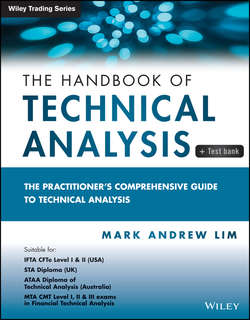Читать книгу The Handbook of Technical Analysis + Test Bank - Lim Mark Andrew - Страница 17
На сайте Литреса книга снята с продажи.
CHAPTER 1
Introduction to the Art and Science of Technical Analysis
1.7 FOUR BASIC ASSUMPTIONS IN THE APPLICATION OF TECHNICAL ANALYSIS
ОглавлениеThere are four underlying premises associated with the application of technical analysis, namely:
1. Price behavior is expected to persist until there is evidence to the contrary.
2. For every bullish indication or interpretation, there exists an equal and opposite bearish indication or interpretation for the same price behavior or phenomena.
3. Extreme bullishness is potentially bearish (and extreme bearishness is potentially bullish).
4. A technical tool or indicator has no real significance except for that attributed to it by market participants.
The first premise is about preserving the status quo. It should be noted that most technical analysis is based on a set of assumptions. Most assumptions derive from one grand underlying premise, that being the preservation the prevailing price behavior. For example, a trend is expected to persist until there is evidence to the contrary. Hence a state of persistence is assumed to be the status quo. If a cycle is identified, it is assumed to persist until cyclic failure is clear and obvious. If the market is in consolidation, it is expected to continue to range until a breakout is identified.
The second premise is also a fairly obvious, not only in relation to technical analysis but also with much of life. For example, an analyst may make a case for rising oil prices as the reason for a rise in the Dow Jones index since it is indicative of increasing demand, representing evidence of a recovering economy. The same analyst may also make a case for rising oil prices as the reason for a decline in the Dow Jones index due to the widely held perception of increasing cost, and hence bearish for the economy in general. Another example would be to find the stochastics at an oversold level and conclude that the current uptrend is strong since it is potentially or implicitly bullish. Alternatively, the stochastics could be at an overbought level, leading to the conclusion that the current uptrend is strong since an overbought level is regarded as explicitly bullish.
The third premise above is obvious when using oscillators such as stochastics, RSI, and MACD. A reading of 100 percent on the stochastics is extremely and explicitly bullish but it is also regarded as a potentially or implicitly bearish condition since it is at a level where price may generally be regarded as being overextended or exhausted. There is an underlying expectation or assumption that a reversion to the means would eventually take place (note that this may not always be true, for example, in the case of cumulative type indicators). A breakout above a rising channel is also explicitly bullish but it is also regarded as implicitly bearish since it also represents a state of overextension or exhaustion in price, with respect to the rising channel formation.
The fourth premise is specifically about the effects of the self-fulfilling prophecy. It is easy to understand why a largely concerted wave of buying or selling at various points on a price chart may cause a significant reaction in price. This concerted wave of buying or selling will generally be more pronounced if these points are significantly clear and obvious to most market participants using technical analysis. Hence we generally notice a larger than average penetration bar during trendline breakouts, especially if the trendline is significantly clear and obvious to most traders. This also implies that should an indicator be essentially faulty or illogical in its design, if enough participants risk actual capital based on its signals, it would begin to exhibit a greater level of reliability.
The Efficacy of Technical Analysis at Various Timeframes
Technical analysis generally works more efficiently at timeframes where there are fewer forms of analyses available. For example, on higher timeframes like the daily, weekly, monthly, or yearly charts, fundamental analysis plays a very important role in helping to forecast potential market action. But at very low timeframes like the one-minute charts, fundamental analysis may not be as useful, especially if the stopsize is very small. In essence, the smaller the stopsize, the more important will be the role of applying technical analysis when trying to forecast very short term movements in price. This is the main reason why technical analysis is generally more reliable at lower timeframes.
